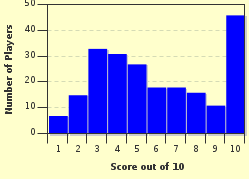Quiz Answer Key and Fun Facts
1. Which company served as the prime contractor on the Saturn V's first stage, the S-IC?
2. The Saturn V's first stage was powered by five Rocketdyne F-1 engines. During the Saturn V's first launch, in November, 1967, how much thrust did each F-1 engine produce?
3. Which company was the primary contractor on the Saturn V's second stage, the S-II?
4. The Saturn V's second stage was powered by five Rocketdyne J-2 engines. Which of the following fuels was used to propel the J-2?
5. The Saturn V's second and third stages used small ullage motors in addition to the J-2 engines. For what purpose were the ullage motors used?
6. Which company served as prime contractor of the Saturn V's third stage, the S-IVB?
7. The Instrument Unit, or IU, provided the brains for the Saturn V. Which company served as the IU's prime contractor?
8. In the Apollo configuration, how tall was the Saturn V?
9. A variant of the Saturn V, the Saturn INT-21, was used to launch the Skylab space station in 1973.
10. All Saturn V rockets lifted off from the Kennedy Space Center in Florida. What number was given to the launch complex from which the Saturn V rockets were launched?
Source: Author
cag1970
This quiz was reviewed by FunTrivia editor
bloomsby before going online.
Any errors found in FunTrivia content are routinely corrected through our feedback system.

